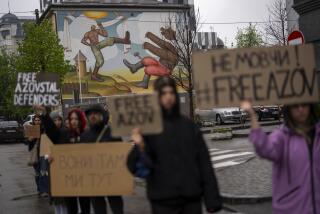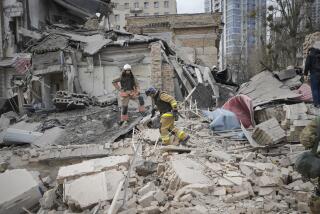Reagan Is Expected to Prevail on Contras Aid : Democrats Concede House Will Vote Military Help, but Doubts on Rebel Effectiveness Persist
- Share via
WASHINGTON — President Reagan stands at the threshold of a long-sought victory this week: a vote in Congress to send U.S. military aid and advisers to the rebels fighting to overthrow Nicaragua’s leftist regime.
A final parliamentary battle remains to be fought in the Democratic-controlled House, where Speaker Thomas P. (Tip) O’Neill Jr. (D-Mass.) has threatened to delay the $100 million in aid by tying it to an appropriation bill that Reagan does not want. But after long and bruising debate, most Democratic leaders concede that Reagan will win approval for U.S. military support of the contras, as the rebels are called.
If the Administration is successful, the vote will be a political landmark, the first time Congress has decided to throw above-board U.S. arms aid directly into the contras’ guerrilla war against the Marxist-led Sandinista government. Reagan and his aides hope that it will also be a turning point for their controversial policy in Central America--the beginning of a long-term U.S. commitment to the rebels.
Probably Not Enough
Administration officials acknowledge that $100 million and 18 months--the term of the aid request--will probably not be sufficient to turn the Sandinistas out of power or transform them into democrats.
“This is not a short-term proposition,” Secretary of State George P. Shultz told a Senate hearing. “I would be guided by the notion of staying power. . . . We are going to stay in there. We are going to support people who fight for freedom.”
Down the road, officials say privately, the Administration will most likely come back to Congress and ask for more aid--and the United States’ role in the war may gradually widen.
As the House takes up the issue again, it will consider several proposals to provide $70 million in military aid and $30 million in non-military aid to the contras, with the military aid delayed for three months to allow a last chance for a negotiated settlement. The Republican-controlled Senate already has approved the aid.
New Tonkin Resolution
Both sides recognize the importance of the vote. Democratic opponents have called it a Gulf of Tonkin resolution, likening it to the vote that gave President Lyndon B. Johnson authority to put U.S. troops into combat in Vietnam. Reagan and his supporters in both parties have portrayed it as the last chance to prevent Nicaragua from turning into a base for Communist expansion throughout Central America and even Mexico--an ambition the Sandinistas have disavowed.
“The Soviet Union, Fidel Castro and the Sandinistas are determined to make the region a Communist enclave,” Reagan said at a news conference last week. “We must not, and we will not, allow that to happen.”
Even the President, however, acknowledged that this week’s aid package will not be enough to enable the contras, an ill-equipped force estimated at 18,000, to defeat the 60,000-man Sandinista army; it can only protect them from collapse.
“The Communists must realize that they cannot crush their opponents, and our assistance can ensure that the freedom fighters are not crushed,” Reagan said. “That assistance will give Nicaraguans a choice, and it will give diplomacy a chance.”
Domestic Opposition
Administration officials say they hope the aid will revive the contras’ moribund military effort and help give them new political appeal within Nicaragua, where opposition to the regime among some groups is widespread but largely ineffective.
The $70 million in military aid, including a training program that officials say could involve as many as 55 U.S. advisers, is intended to help the contras expand immediately to 25,000 fully equipped troops, far more than they have fielded before.
But when asked to outline their vision of how the war will go, Administration officials offer only vague scenarios, asserting that the contras can fight well enough to destabilize the Sandinista government but denying any U.S. interest in a military victory.
“The answer to the question depends on what the people of Nicaragua want,” Assistant Secretary of State Elliott Abrams told members of Congress last week. “A force of 25,000 men and women, supported by the people of Nicaragua, as the contras are supported already, . . . will bring enormous pressure on the government of Nicaragua.
Army-to-Guerrilla Ratio
“The usual ratio that you need of 8 or 10 troops (pursuing each rebel) to defeat a guerrilla force . . . will be unavailable to the Sandinistas,” he said. “If they’re facing 25,000 in the field, they won’t have an army of 250,000.”
The result, he suggested, will be the classic guerrilla goal--a bloody stalemate that will gradually weaken the Sandinistas and force them to negotiate or collapse.
“We should see a significant change within a year or two,” an aide to Abrams added. “We’re not talking about a 30-year war.”
Other officials say that Abrams is too optimistic and that even with U.S. advisers, the contras will prove to be no match for the Sandinistas’ special counterinsurgency battalions.
“Their training and command are so poor now (that) nobody really knows whether they can get it together,” an official said.
If the stalemate continues, Administration critics say that the United States could eventually face an agonizing choice: either intervene directly with military force or abandon the fight.
Lawmakers’ Doubts
“I don’t believe $100 million will do the trick, and I don’t know of anybody that does,” Sen. Dale Bumpers (D-Ark.) told Shultz. “That means that next year you will be back here asking for another $100 million or $200 million. And the year after that. . . .
“Assume that the contras are losing and that the Sandinistas have solidly entrenched themselves--and there we sit,” Bumpers said. “What do we do then? Do we send the Marines in?”
Shultz replied: “I don’t know how I can possibly respond to what the situation might be like three years from now.”
Even if the contras do turn into a genuine threat to the Sandinistas, some Democrats have posed a nightmare scenario: What happens if a large rebel unit is surrounded by the Sandinistas and threatened with annihilation--and contra commander Enrique Bermudez appeals to Reagan for help to get his men out?
“It’s not all that likely to happen,” a senior State Department official said. But when pressed for an answer, he noted: “There are steps short of sending in the 82nd Airborne. . . . We’ve already suggested that if the Sandinistas acquired jet fighters, we’d use air power to take them out.”
Concern About Bermudez
Another official expressed this worry: “Enrique Bermudez has always wanted us to intervene. . . . He wouldn’t be above something like that.”
By that time, however, Reagan aides hope the U.S. political commitment to the contras, both in Congress and among the public, will be firmer than it is today.
Meanwhile, the Administration plans to try to improve the contras’ image by revamping their political leadership and promoting a “human rights” campaign to end abuses that the ill-disciplined guerrillas have committed.
And Administration officials predict that the Sandinistas will continue to lose support in the United States by intensifying repression at home--partly in reaction to the contras’ growth--and refusing to make concessions in regional peace talks.
“There are no moderates in Managua anymore,” a State Department official said.
Nor, he agreed, are there in the Reagan Administration. The internal debates over whether a negotiated compromise is possible between the United States and the Sandinistas are largely over, officials say. Only a basic change in the nature of the Managua regime will meet the Administration’s requirements.
Administration’s Evolution
The Reagan Administration has come a long way from the days when it refused to acknowledge its covert support for the guerrillas, or the days when it argued that its covert aid was intended only to stop Nicaraguan arms shipments to El Salvador’s leftist rebels. More important, it has come a long way since 1984, when Democrats in Congress marshaled a solid majority to cut off the aid entirely, leaving the contras to survive on their own for a year.
More and more Democrats have swung to Reagan’s side on the issue of Nicaragua. Some have been enthusiastic and some reluctant, but White House and State Department aides insist that the President’s hard-line rhetoric on the issue has made headway in winning long-term support.
“We face a genuine dilemma,” said Sen. Bill Bradley (D-N.J.), a liberal who broke with his colleagues to vote in favor of Reagan’s aid request.
“The Administration’s failed policies have alienated potential allies, facilitated consolidation of the Sandinista regime and may have precipitated the outbreak of a regional war,” he said.
But Bradley added: “I also believe the Nicaraguan people deserve a chance at democracy. That chance will be denied them if the Sandinistas are allowed to consolidate their totalitarian regime. . . . In the final analysis, the President has left us little choice but to back the contras.”
More to Read
Sign up for Essential California
The most important California stories and recommendations in your inbox every morning.
You may occasionally receive promotional content from the Los Angeles Times.














